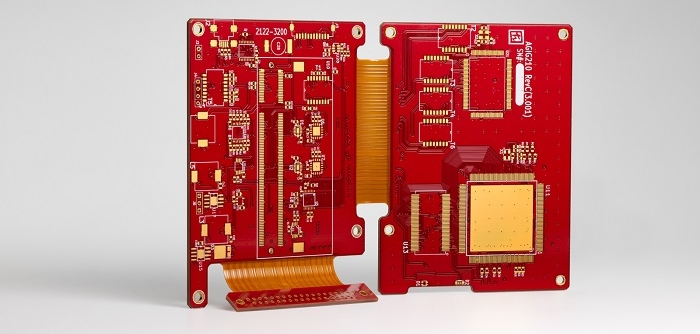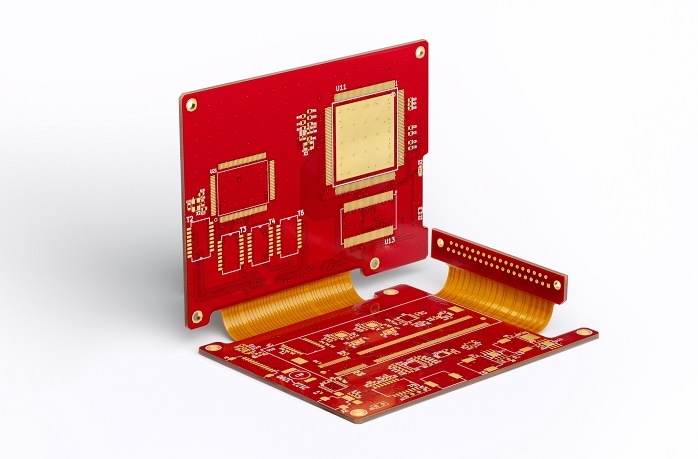Flexible Circuit Boards, commonly known as Flex PCBs or simply Flex circuits, represent electronic connectivity solutions that employ a pliable substrate material rather than a rigid one. They are typically crafted from materials like polyimide (PI) or polyester (PET), affording them the capacity to flex and adapt to various contours and angles. These Flex PCBs encompass etched conductive pathways on the flexible substrate and may also integrate components such as resistors, capacitors, and integrated circuits (ICs) tailored to specific use cases.
Electronic Product Flexible Circuit Board finds extensive application in scenarios where spatial constraints, weight reduction, or adaptability are pivotal considerations. Prominent areas of use encompass aerospace and aviation, medical apparatus, automotive electronics, wearable technology, and consumer electronics.

Advantages of Flexible Circuit Boards in Electronic Products
Flexible Circuit Boards (Flex PCBs) offer a myriad of benefits for electronic products, positioning them as a preferred choice across various industries. Below are the primary advantages:
Flexibility and Bendability
Space-efficient adaptability: Flex PCBs possess the unique capability to be bent, folded, or contoured precisely to snugly fit into confined or irregularly shaped spaces within electronic devices. This adaptability proves indispensable in designs where spatial constraints are paramount.
Simplified routing in compact devices: The inherent flexibility of Flex PCBs simplifies the process of routing traces and connections within small electronic devices. This results in more efficient space utilization and enhanced design flexibility.
Weight and Size Reduction
Inherent lightweight design for portability: Flex PCBs exhibit a natural lightweight characteristic, making them exceptionally suitable for portable electronic devices like smartphones, tablets, and wearables. This reduced weight contributes significantly to overall device portability and user comfort.
Facilitation of miniaturization: Flex PCBs enable the miniaturization of electronic components and devices. Their ability to be tightly folded or rolled facilitates the creation of smaller, more compact products.
Enhanced Reliability
Reduced interconnections, mitigating potential failure points: Flex PCBs typically feature fewer solder joints and interconnections compared to their rigid counterparts. This reduction diminishes the likelihood of signal degradation and failures stemming from connection-related issues.
Resilience to vibrations and movement: Flex PCBs excel in applications where vibrations and movement are commonplace, such as automotive electronics and aerospace. Their flexibility and secure attachment minimize the risk of damage caused by mechanical stresses.
Cost-Effective Manufacturing
Streamlined assembly processes: Flex PCBs often necessitate less assembly time due to their simplified design and the elimination of complex wire harnesses. This streamlined assembly can result in cost savings during the manufacturing phase.
Reduced material requirements: The inherent flexibility of Flex PCBs can reduce the need for additional mechanical components, connectors, and fasteners. This not only streamlines the manufacturing process but also lowers material costs.
Improved Thermal Management
Effective heat dissipation for high-performance electronics: Flex PCBs excel at efficiently dissipating heat generated by high-performance electronic components. Their flexible nature enables effective thermal management, ensuring that the device remains within safe operating temperatures.
Key Applications of Flexible PCBs in Electronic Products
Flexible Circuit Boards (Flex PCBs) play pivotal roles in various electronic product categories due to their distinctive attributes. Here are significant application domains:
Wearable Electronics
Smartwatches, fitness bands, etc.: Flex PCBs empower the creation of wearable devices that seamlessly conform to the body's contours, ensuring both comfort and adaptability. They facilitate the integration of sensors, displays, and connectivity components within compact form factors.
Medical Devices
Implantable devices, medical imaging, etc.: In the realm of medical devices, Flex PCBs are instrumental. They find application in implantable sensors and pacemakers, benefiting from their flexibility that accommodates the human body's shape. Additionally, they are employed in medical imaging equipment due to their reliability and space-saving advantages.
Aerospace and Defense
Spacecraft, missiles, and other advanced applications: Flex PCBs hold paramount importance in aerospace and defense. Their ability to withstand extreme conditions, vibrations, and confined spaces is indispensable. They are deployed in satellites, missile guidance systems, and various advanced electronic components.
Consumer Electronics
Cameras, smartphones, and other compact devices: Flex PCBs are of critical significance in consumer electronics, where spatial constraints are paramount. They enable the creation of compact designs for devices like smartphones, digital cameras, and tablets, thereby enhancing portability and user-friendliness.
Automotive Industry
In-vehicle systems, sensors, and more: The automotive sector heavily relies on Flex PCBs for in-vehicle systems encompassing infotainment, navigation, and instrument clusters. Moreover, they are employed in sensors and control units, benefiting from their resistance to vibration and fluctuations in temperature.
Flexible Circuit Boards demonstrate remarkable versatility and adaptability, cementing their status as integral components in the realm of electronic product design across this array of diverse application domains. Their capacity to fulfill specific requisites concerning space, reliability, and adaptability renders them indispensable in contemporary technology-driven industries.
Challenges and Considerations When Utilizing Flex PCBs
While Electronic Product Flexible Circuit Board offers a multitude of advantages, their application is accompanied by certain challenges and considerations that necessitate attention. Below are key factors to bear in mind:
Durability Concerns
Potential wear and tear from bending and flexing: Frequent bending and flexing can subject Flex PCBs to mechanical stress, potentially leading to damage over time. To address durability concerns, meticulous design, and material selection are imperative.

Complex Design Process
Requires specialized knowledge and tools: Designing Flex PCBs demands a deep understanding of flexible circuitry, as well as proficiency in utilizing specialized design software and fabrication techniques. Collaborative efforts with experienced engineers and manufacturers are often essential for successful implementation.
Cost Implications
The initial cost may be higher compared to rigid PCBs: The manufacture of Flex PCBs can incur higher initial costs due to the need for specialized materials and tailored design requirements. Nonetheless, potential cost savings can be realized through reduced assembly and material expenses, coupled with enhanced long-term reliability.
Material Limitations
Specific materials required to ensure flexibility without compromising integrity: Flex PCBs rely on materials such as polyimide (PI) or polyester (PET) to provide flexibility while preserving electrical and mechanical integrity. Material selection must align with the intended application to avoid performance-related issues.
Effectively addressing these challenges and considerations demands a comprehensive grasp of Flex PCB technology and its associated implications. While Flex PCBs offer unique advantages, meticulous planning and execution are indispensable to ensure their successful integration into electronic products.
CONCLUSION
In summary, the Electronic Product Flexible Circuit Board stands as a remarkable leap forward in the realm of electronic interconnect solutions. Their capacity to bend, conform, and seamlessly inhabit non-traditional spaces endows them with a wealth of advantages, rendering them the preferred choice across diverse industries.
Nonetheless, it's imperative to recognize the challenges and considerations that accompany the utilization of the Flexible Circuit Board. These encompass durability concerns stemming from repeated bending, intricate design processes necessitating specialized knowledge and tools, initial cost implications, and the requirement for specific materials to balance flexibility with integrity. Successfully harnessing the potential of Flex PCBs hinges on meticulous planning and the application of expertise.
Despite these challenges, the trajectory of Flex PCBs remains poised to redefine the landscape of electronic product design. Their intrinsic flexibility and adaptability are poised to address the ever-evolving needs of technology-driven industries, offering the promise of more compact, dependable, and groundbreaking electronic devices. The future of electronic interconnect solutions, epitomized by Flex PCBs, holds the key to unlocking new realms of innovation and possibility.










 2023-10-26
2023-10-26
 BEST
BEST

.png)
.png)
.png)
.png)

.png)

